Keywords
|
| Traffic, Multimedia, Efficient,framework, Network,queuing. |
I.INTRODUCTION
|
| IP Multimedia Subsystem (IMS) is framework, basically specified for mobile networks, for providing Internet Protocol (IP) telecommunication services. It is the technology that will merge the Internet (packet switching) with the cellular world (circuit switching). Presence is one of the basic services that is likely to become omnipresent in IMS. It is the service that allows a user to be informed about the reach ability, availability, and willingness of communication of another user. The presence service is able to indicate whether other users are online or not and if they are online, whether they are idle or busy.[1]IMS can be divided into three layers. The lower layer iscalled as user plan and it accommodates all the userswho want to use different IMS services. In order to obtainservices a user contacts the layer two known as IMScorewhere authentication and authorization takes place. IMScore mainly consists of Call Session Control Functions(CSCFs) and databases. The upper layer contains theapplication servers to provide different kind of services. Serving call session control function (S CSCF): it is one of the main entities of the IMS. S-CSCF is responsible for user registration, session setup routing and maintenance of the user’s profiles [2]. Congestion is designed to facilitate the use of IMS Next Generation Networks(NGN). Capabilities by authorized users for effective communications during traffic Congestion, communication and transportation systems. To determine queuing performance measurements, any development of analytically tractable methods will have important help. There were many studies on priority queuing models. [3] |
| Considering a queuing system with two kinds of packets, when a packets of high priority class arrives the S-CSCF (high priority packets), packets finds the S-CSCF is serving for a packets of low priority class(low priority packets), high priority packets squeezes the low priority packets -in-service out and receives service at once. At the same time, packets belonging to same class obey the FCFS discipline, this mechanism is called preemptive priority queuing. If the arriving packet of low priority class finds the S-CSCF is serving for a packet of high priority class should he wait a period until the packet -in-service finishes its service, then begins receiving service, packets belonging to same kind obey the FCFS discipline, this mechanism is called non-preemptive priority queuing. Obviously, first class of packets have high priority over the second class of packets [4]. |
II.IMS OVERVIEW
|
| The IP Multimedia Subsystem (IMS) is a service delivery platform which establishes and controls Internet Protocol (IP) multimedia sessions between providers and customers. The development of IMS was mainly motivated by the idea of merging different network technologies to a layered all-IP network, with the possibility for providers to save costs by only managing a network of one kind instead of multiple kinds. The central components of the IMS are proxies and servers called Call Session Control Functions (CSCF’s) and Home Subscriber Server (HSS), which form part of the IMS Layer depicted in Figure 1. |
| The main task of these components is to process the signaling needed for the provision of services or applications offered by the Service Layer. The Service Layer consists of servers, which can be of heterogeneous type, offering applications to the User Endpoints (UE) located in the Endpoints Layer. One of the main ideas of the IMS is the vision of having a network infrastructure ready to use any mobile device and at the same time to be able of running any application offered by the Service Layer. Implementation queuing discipline in IMS to achieve high quality telecommunication services. We consider S-CSCF as single server where congestion occurs [5]. |
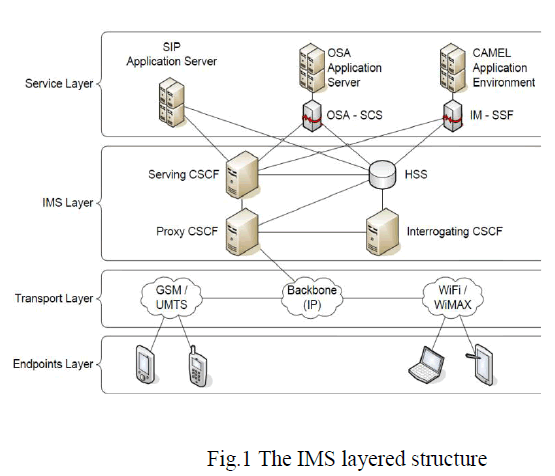 |
| IMS can be divided into three layers. The lower layer is called as user plan and it accommodates all the users who want to use different IMS services. In order to obtain services a user contacts the layer two known as IMS core where authentication and authorization takes place. IMS core mainly consists of Call Session Control Functions (CSCFs) and databases. The upper layer contains the application servers to provide different kind of services [9]. |
III.MODEL DESCRIPTION
|
| We consider the S-CSCF as a single server queuing system serving two types of traffic (packets): class-1 (or high priority class) and class-2 (or low priority class) packets. The arrival process for both classes is state independent; we base our analysis on the following assumption: |
| 1- Arrivals for both classes are independent stationary Poisson processes with mean arrival rate λ1, λ2 for class 1 and class 2, respectively. |
| 2- Service time for all packets follow the negative exponential distribution, average service time is 1/μ where μ is the mean packet departure rate from the server |
| 3- Class-1 packets have non-pre-emptive priority over class-2 packets; we assume buffer capacity is infinite. |
| 4- Packet for both classes are served according to First in First out discipline ( FIFO) |
| Fig.2 shows the queuing model of the system. |
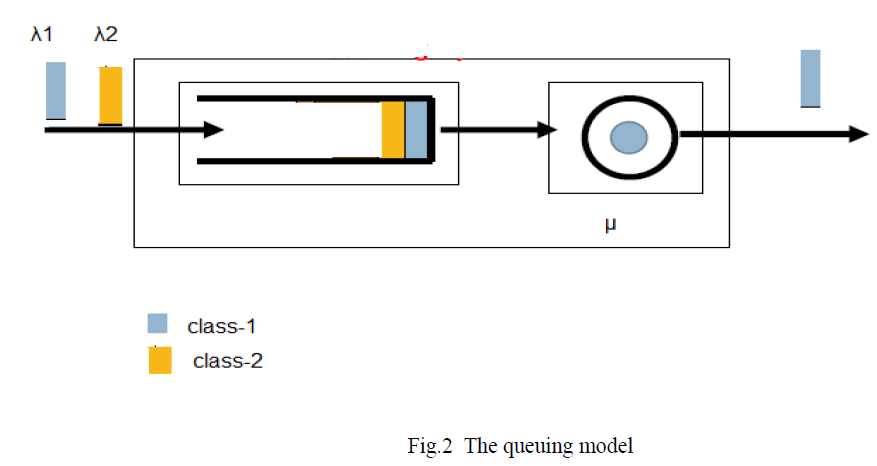 |
IV.PERFORMANCE ANALYSIS
|
| This section will evaluate the performance of the IMS system based on an analytical model. We will use the mathematical model developed by [6 ].The performance parameters of information one average q no. of class1 &2 packets in the systems and the memory delay of class 1 and class 2 packets. We define N(t) as the state of the system as |
 |
| Where, |
| N1 (t): Number of class 1 in the System. |
| N2 (t): Number of class2 in the system. |
| : 1 the server service class 1. |
| : 2 the server service class 2. |
| The Markov chain of the model is shown in Fig.3[7]. |
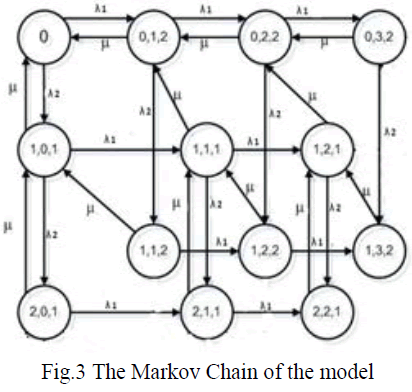 |
| From the Markov chain, the average number of class-1 packets in the system is given by [8]. |
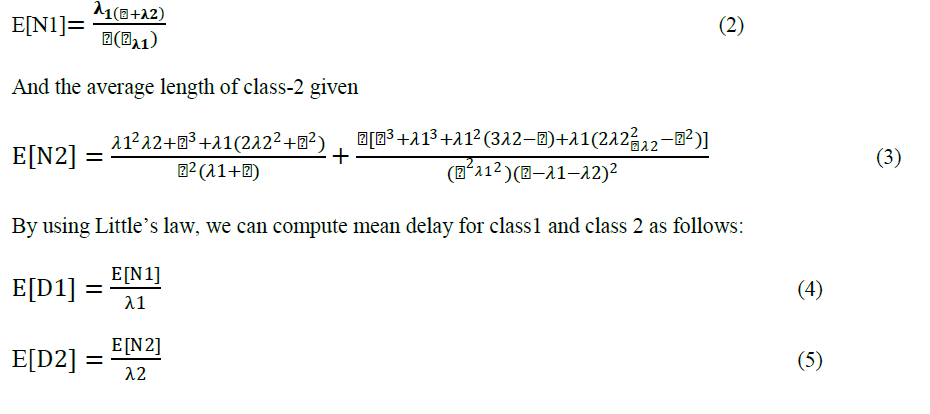 |
| MPUE: In this attack, the objective is to obstruct the DSA process of SUs- i.e., prevent SUs from detecting and using vacant licensed spectrum bands, causing denial of service. |
| Using the Trust-Worthy algorithm it defines a threshold value to the SUs to overcome the PUE attacks. It enables CRNetworks nodes to efficiently utilize the available spectrum channels. Nodes, which can easily find various licensed channel opportunities without interfering the primary system increases. This reveals that it has a potential to be able to convert the various network conditions into a performance improvement. |
V. RESULTS AND ANALYSIS
|
| Mean Delay |
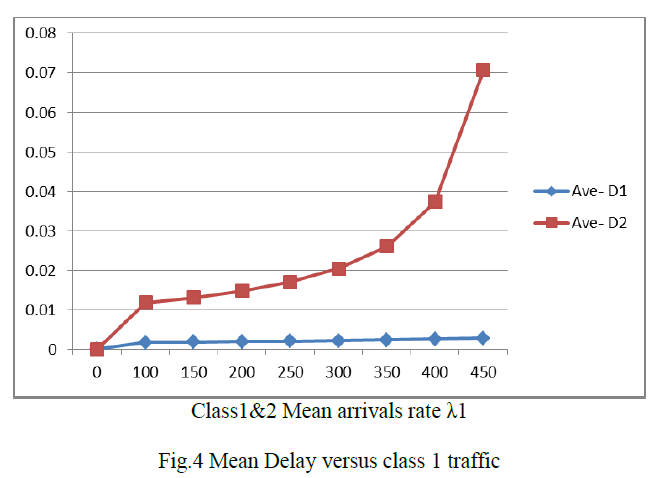 |
VI.CONCLUSION
|
| In this paper .we proposed the architecture for harmonizing S-CSCF with two priority classes traffic to minimize average delay time of higher priority when traffic jam accrue . We presented the benefits of harmonizing S-CSCF to minimize average Delay of Higher priority class. With regard traffic jam in S-CSCF we proposed to maximize the average delay time of low priority class. In evaluation of the average delay time we compare the effected delay time by increasing mean arrival of high priority class. We thus showed that the lowest average delay time of low priority class when the the average delay time of high priority class low. The average delay time of low priority class increasing corresponding to increasing the mean arrival of high priority class. |
References
|
- Zeeshan, K., Mohamed, S., Khalid, R., Aneel, R., 2010, Presence enabled conditional call setup model for IPmultimedia subsystem.
- Mohamed., A, Wu., A, Cost Analysis of the IMS Presence Services.
- P.G. Harrison and Y. Zhang, “Delay analysis of priority queues with modulated traffic”, 2005.
- Alam MT, Zheng da W (2007) Admission control approaches in the IMS presence service
- Poikselka M, Georg M, Hisham K, Aki N (2006). IP multimedia concepts and services” 2nd Edition.
- Asha Seth Kapadia, Analysis of a Finite Capacity Non-preemptive Priority Queue ,Comput. &. Ops.Res.J.3(1984), 337-343.
- D. R.Miller, “Computation of Steady-State Probabilities for M/M/1 Priority Queues,” Operations Research, vol.29, no.5, pp. 945-958, Sept.-Oct. 1981.
- Zhao Guo-xi M/M/1 Queuing System with Non-preemptive Priority.
- Alam MT, Zheng da Wu (2005). “Cost Analysis of the IMS Presence Service”, 1st Australian ConfrenceonWireless Broadband and Ultra Wideband Communication, 2006.
|